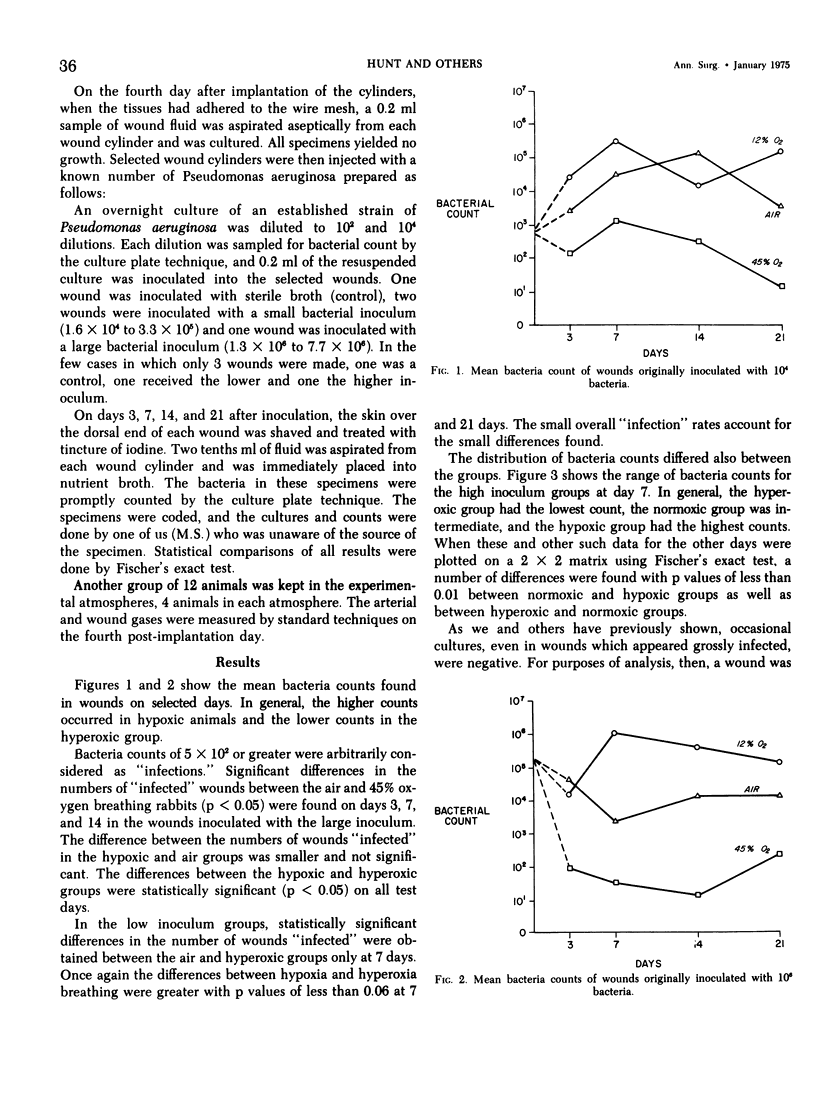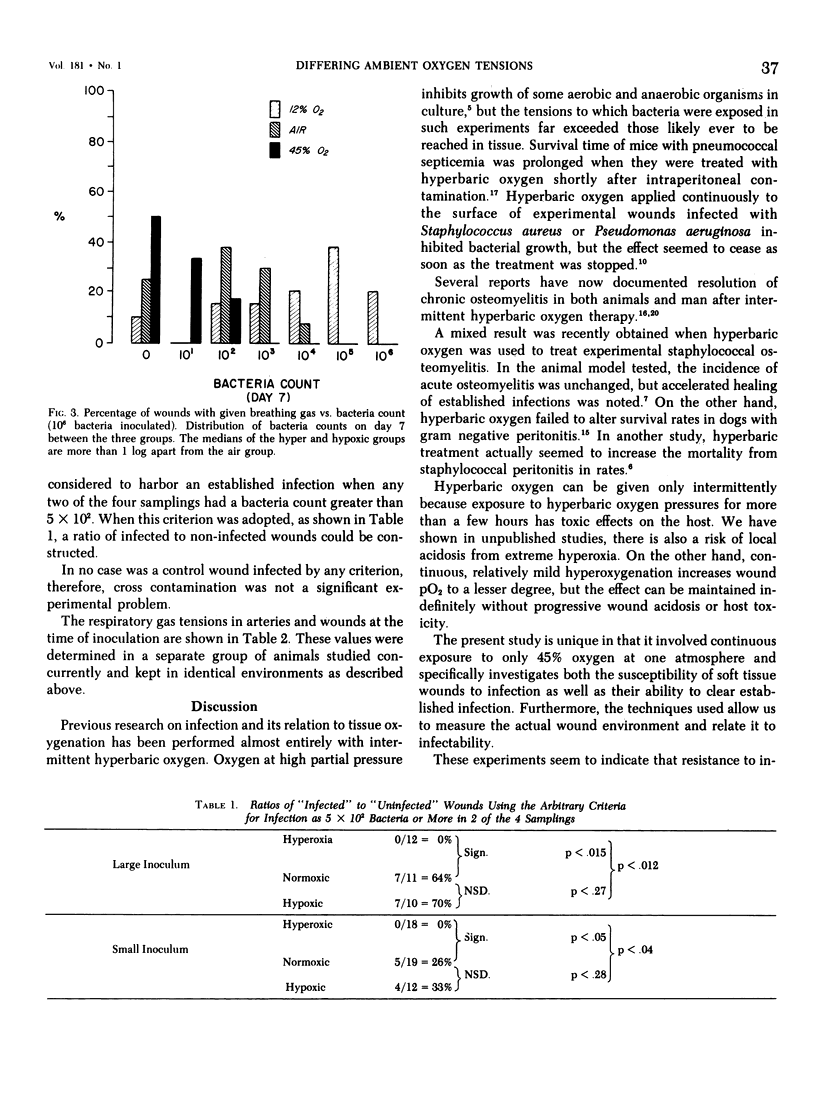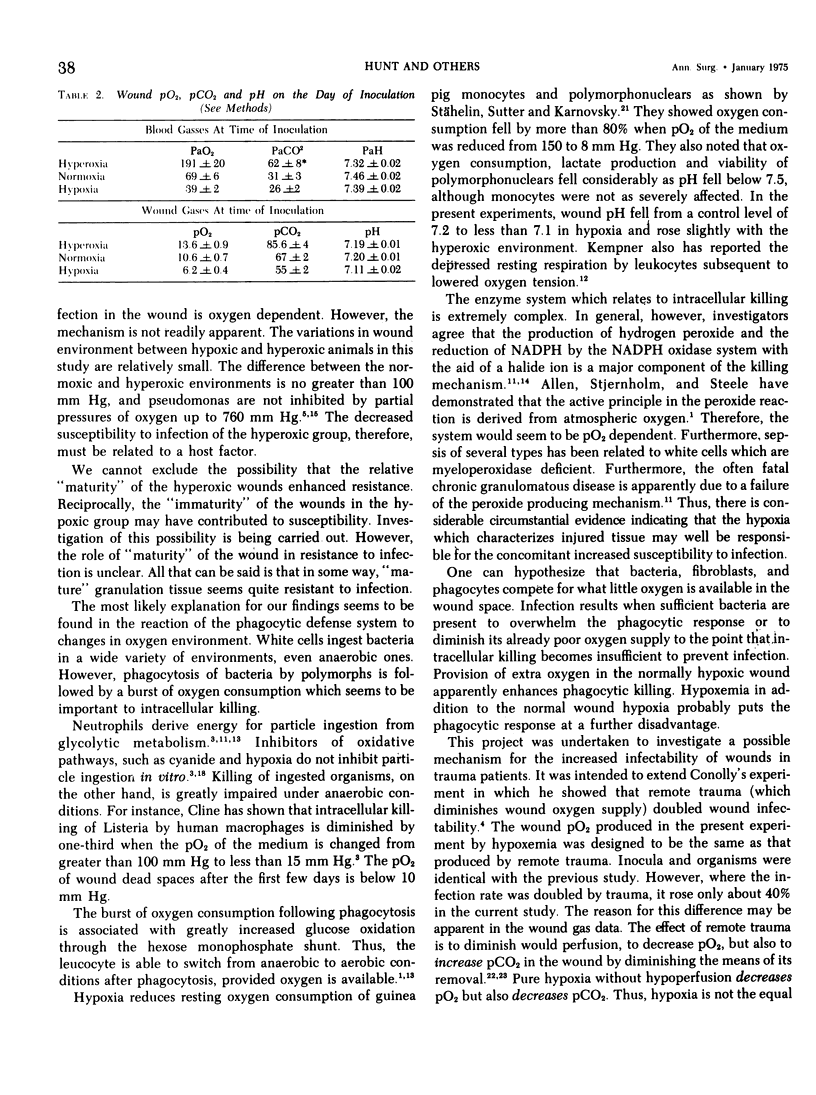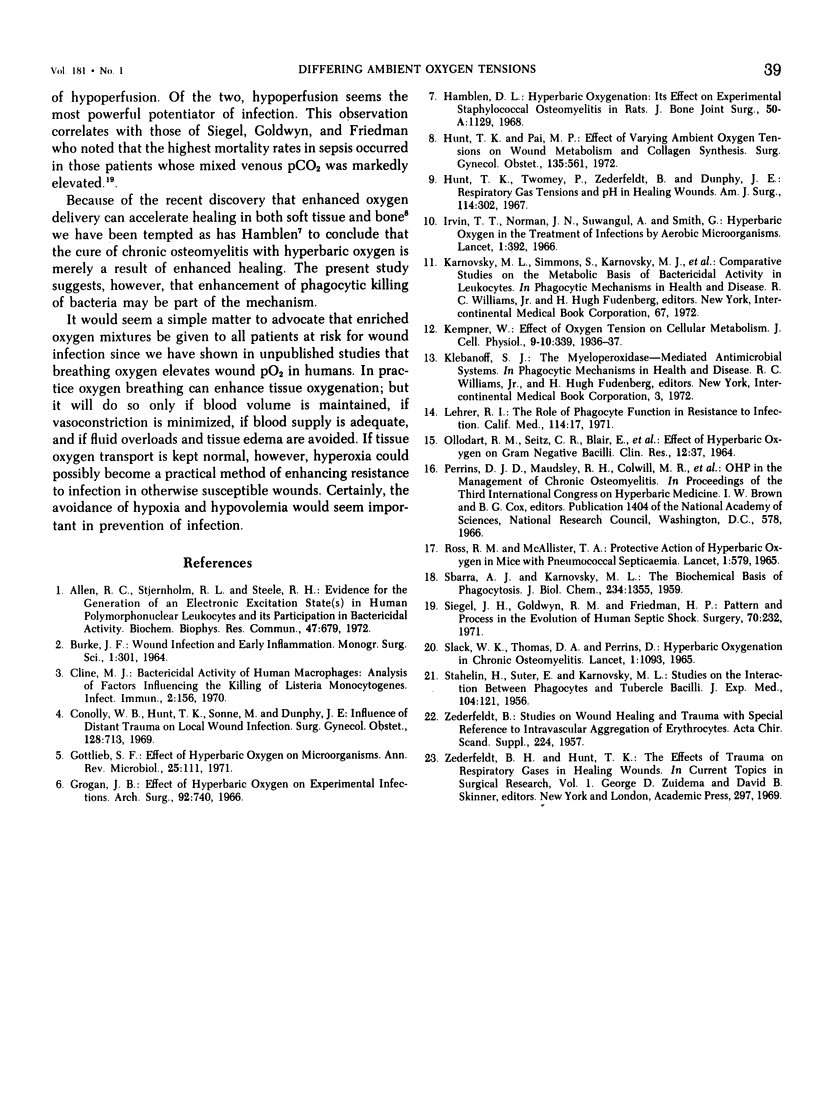Abstract
Wound infections were studied in rabbits using two standard inocula (approximately equal to 10-4 and approximately equal to 10-6) of Pseudomonas aeruginosa injected into subcutaneous wound dead space made by implantation of standard wire mesh cylinders. The inoculation was done on the fourth day after implantation of the cylinders in animals kept from the day of implantation in atmospheres of 12%, 21%, or 45% oxygen content. Samples of wound fluid (0.2 ml) were removed for quantitative culture just before inoculation and 3, 7, 14, and 21 days later. No positive cultures resulted from samples taken before inoculation. One uninoculated wound served as a control in each animal. None of these control wounds became infected. Culture counts were significantly highest in the anoxic group and lowest in the hyperoxic group. Established infections were significantly lowest in the hyperoxics and highest in the hypoxics. The percent of wounds showing a significant culture count showed a similar trend. The mechanisms of this effect is not known, but a possible mechanism lies in the relative inability of leucocytes to kill this bacterium under hypoxic conditions.
Full text
PDF




Selected References
These references are in PubMed. This may not be the complete list of references from this article.
- Allen R. C., Stjernholm R. L., Steele R. H. Evidence for the generation of an electronic excitation state(s) in human polymorphonuclear leukocytes and its participation in bactericidal activity. Biochem Biophys Res Commun. 1972 May 26;47(4):679–684. doi: 10.1016/0006-291x(72)90545-1. [DOI] [PubMed] [Google Scholar]
- BURKE J. F. WOUND INFECTION AND EARLY INFLAMMATION. Monogr Surg Sci. 1964 Dec;1:301–345. [PubMed] [Google Scholar]
- Cline M. J. Bactericidal Activity of Human Macrophages: Analysis of Factors Influencing the Killing of Listeria monocytogenes. Infect Immun. 1970 Aug;2(2):156–161. doi: 10.1128/iai.2.2.156-161.1970. [DOI] [PMC free article] [PubMed] [Google Scholar]
- Conolly W. B., Hunt T. K., Sonne M., Dunphy J. E. Influence of distant trauma on local wound infection. Surg Gynecol Obstet. 1969 Apr;128(4):713–718. [PubMed] [Google Scholar]
- Gottlieb S. F. Effect of hyperbaric oxygen on microorganisms. Annu Rev Microbiol. 1971;25:111–152. doi: 10.1146/annurev.mi.25.100171.000551. [DOI] [PubMed] [Google Scholar]
- Grogan J. B. Effect of hyperbaric oxygen on experimental infections. Arch Surg. 1966 May;92(5):740–742. doi: 10.1001/archsurg.1966.01320230088016. [DOI] [PubMed] [Google Scholar]
- Hamblen D. L. Hyperbaric oxygenation. Its effect on experimental staphylococcal osteomyelitis in rats. J Bone Joint Surg Am. 1968 Sep;50(6):1129–1141. [PubMed] [Google Scholar]
- Hunt T. K., Pai M. P. The effect of varying ambient oxygen tensions on wound metabolism and collagen synthesis. Surg Gynecol Obstet. 1972 Oct;135(4):561–567. [PubMed] [Google Scholar]
- Hunt T. K., Twomey P., Zederfeldt B., Dunphy J. E. Respiratory gas tensions and pH in healing wounds. Am J Surg. 1967 Aug;114(2):302–307. doi: 10.1016/0002-9610(67)90388-1. [DOI] [PubMed] [Google Scholar]
- Irvin T. T., Norman J. N., Suwanagul A., Smith G. Hyperbaric oxygen in the treatment of infections by aerobic microorganisms. Lancet. 1966 Feb 19;1(7434):392–394. doi: 10.1016/s0140-6736(66)91390-0. [DOI] [PubMed] [Google Scholar]
- Lehrer R. I. The role of phagocyte function in resistance to infection. Calif Med. 1971 Jun;114(6):17–25. [PMC free article] [PubMed] [Google Scholar]
- ROSS R. M., MCALLISTER T. A. PROTECTIVE ACTION OF HYPERBARIC OXYGEN IN MICE WITH PNEUMOCOCCAL SEPTICAEMIA. Lancet. 1965 Mar 13;1(7385):579–581. doi: 10.1016/s0140-6736(65)91149-9. [DOI] [PubMed] [Google Scholar]
- SBARRA A. J., KARNOVSKY M. L. The biochemical basis of phagocytosis. I. Metabolic changes during the ingestion of particles by polymorphonuclear leukocytes. J Biol Chem. 1959 Jun;234(6):1355–1362. [PubMed] [Google Scholar]
- SLACK W. K., THOMAS D. A., PERRINS D. HYPERBARIC OXYGENATION CHRONIC OSTEOMYELITIS. Lancet. 1965 May 22;1(7395):1093–1094. doi: 10.1016/s0140-6736(65)92676-0. [DOI] [PubMed] [Google Scholar]
- STAHELIN H., SUTER E., KARNOVSKY M. L. Studies on the interaction between phagocytes and tubercle bacilli. I. Observations on the metabolism of guinea pig leucocytes and the influence of phagocytosis. J Exp Med. 1956 Jul 1;104(1):121–136. doi: 10.1084/jem.104.1.121. [DOI] [PMC free article] [PubMed] [Google Scholar]
- Siegel J. H., Goldwyn R. M., Friedman H. P. Pattern and process in the evolution of human septic shock. Surgery. 1971 Aug;70(2):232–245. [PubMed] [Google Scholar]


